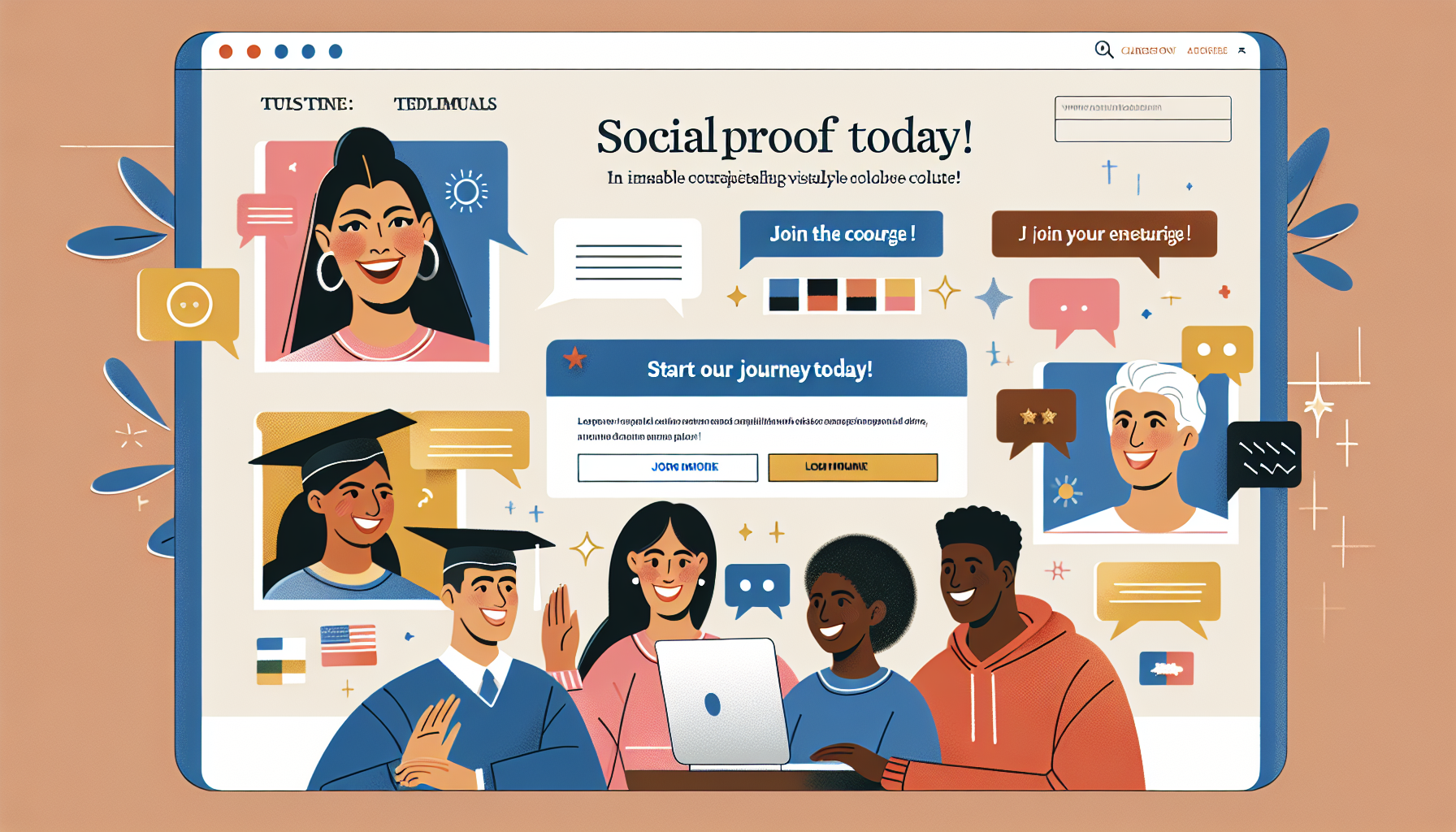Are you struggling to turn visitors into customers on your course sales pages? You’re not alone! Many course creators face the same challenge, and it can be frustrating when all your hard work doesn’t pay off.
But guess what? If you stick with me, I’ll share some straightforward tips that could supercharge your conversion rates. No jargon here—just practical advice that you can start implementing right away.
From crafting catchy headlines to utilizing social proof and optimizing for mobile, we’ll cover all the essentials. By the end, you’ll be better equipped to transform those curious clicks into committed enrollments!
Key Takeaways
- Know your audience: Understand their demographics and what motivates them to choose your course.
- Create compelling headlines that grab attention and highlight the course’s value.
- Use engaging course descriptions that sell the experience and outline clear benefits.
- Incorporate high-quality images and an authentic intro video to enhance engagement.
- Show social proof with testimonials to build trust and credibility.
- Implement clear and compelling calls to action to guide users toward enrollment.
- Improve page load speed to reduce bounce rates and keep visitors engaged.

How to Optimize Course Sales Pages for Better Conversion Rates
Understanding Your Target Audience
To effectively optimize your course sales page, start by understanding who your target audience is.
Research their demographics, interests, pain points, and what motivates them to seek out courses.
You can use surveys or social media polls to gain insights directly from your audience.
Once you have this data, tailor your content to address their specific needs and desires.
For example, if your audience consists mainly of busy professionals, highlight how your course can save them time and improve their skills efficiently.
By speaking directly to their motivations, you can significantly increase engagement and keep visitors on your page longer.
Creating a Compelling Headline
Your headline is the first thing visitors will see, so make it count.
It should be clear, concise, and convey the value of your course in a way that hooks readers.
Consider using powerful words that evoke emotions or create a sense of urgency.
For instance, something like “Unlock Your Potential: Master Digital Marketing in 30 Days!” can grab attention better than a simple “Digital Marketing Course.”
Test different headlines to see which resonates more with your audience and leads to higher engagement rates.
Tools like A/B testing can provide valuable insights into what works best.
Crafting Engaging Course Descriptions
Your course description should not just tell what the course is about; it should sell the experience.
Begin with a strong opening statement that captures the essence of the course and addresses the learner’s goals.
Break down what students will learn, the skills they will acquire, and how the course will benefit them in real-life scenarios.
Use bullet points for easy reading and include testimonials or quotes from previous students to build trust.
Don’t forget to highlight features such as lifetime access, community support, or additional resources, as these can sway a potential buyer’s decision.
Finally, remember to convey your excitement and passion for the subject matter; it helps to create an inviting atmosphere.
Using High-Quality Images and Videos
Visual content plays a huge role in keeping visitors engaged and increasing conversion rates.
Invest in high-quality images that depict course content, such as screenshots of modules or engaging visuals related to the subject.
Videos can particularly enhance your sales page; consider creating a brief introductory video explaining your course and what students can expect.
Make sure your video is authentic, showcasing your personality and what differentiates your course from others.
According to studies, pages with videos are more likely to retain visitors, increasing the average time on the page.
Plus, visual elements add a professional touch that builds credibility, making it easier for potential students to trust you.

Incorporating Social Proof and Testimonials
Social proof and testimonials can significantly impact conversion rates on your course sales page.
As humans, we often look to others when making decisions.
Including positive feedback from past students provides reassurance that your course delivers value.
Feature testimonials prominently, perhaps in a dedicated section or as highlighted quotes throughout the page.
Video testimonials can be particularly impactful as they add a personal touch and authenticity.
Make sure to select testimonials that address specific benefits and outcomes, such as skill improvement or career advancements.
Displaying real names and possibly photos also increases credibility.
Consider using platforms like Trustpilot or Google Reviews to gather and showcase genuine reviews.
Overall, creating a sense of community and trust can motivate new students to enroll.
Implementing Clear Calls to Action
A clear call to action (CTA) is essential for directing potential students toward enrollment.
Make your CTA buttons stand out using contrasting colors and compelling text.
Instead of a mundane “Submit,” try something more engaging, like “Join the Course Today!” or “Start Your Journey Now!”
Position your CTAs strategically, placing them at the end of your course description and throughout the page where it feels natural.
If visitors have questions or concerns, a well-placed CTA like “Need More Info? Contact Us!” can also keep the conversation going.
Additionally, consider using an exit-intent popup to remind users of what they’ll miss if they leave without signing up.
Lastly, test different variations of your CTAs to find out which wording and placement yield the best results.
Improving Page Load Speed
Page load speed can make or break your conversion rates, as slow-loading pages increase the bounce rate.
In fact, a delay of just one second can lead to a 7% reduction in conversions.
To enhance load speed, start by optimizing images and videos; use formats like WebP for images and compress files to reduce their size.
Consider leveraging a Content Delivery Network (CDN) to reduce server response time, especially if you have a global audience.
Removing unnecessary plugins and scripts can also help streamline your page.
Use tools like Google PageSpeed Insights to identify what could be slowing your site down and prioritize addressing those issues.
Regularly check your load speed, as ensuring a quick, seamless experience keeps visitors engaged and improves their likelihood of enrolling.

Mobile Optimization for Course Sales Pages
Mobile optimization is crucial since many users will visit your course sales page from their smartphones or tablets.
Start by ensuring your site has a responsive design that adjusts seamlessly to different screen sizes.
Test your page on various devices to see how it looks and functions; make adjustments based on these tests.
Keep your content concise and easy to read on smaller screens, as lengthy paragraphs can deter mobile users.
Make buttons and links large enough to tap without zooming in, and ensure that forms are user-friendly.
Lastly, use tools like Google’s Mobile-Friendly Test to check if your page meets mobile optimization standards.
Testing and Analyzing Performance
Testing and analyzing your course sales page’s performance is essential to boosting conversions.
Start with A/B testing different elements like headlines, CTAs, and images to see what resonates more with visitors.
Use analytics tools like Google Analytics to track visitor behavior and identify drop-off points.
Monitor conversion rates regularly to assess the effectiveness of changes and adjust your strategies accordingly.
Look at metrics such as session duration, bounce rate, and the number of returning visitors to gain insights.
Based on these findings, continuously iterate on your sales page to keep improving the user experience and conversion rates.
FAQs
Key elements include understanding your target audience, an engaging headline, detailed course descriptions, high-quality images/videos, social proof, clear calls to action, and mobile optimization for accessibility.
To improve load speed, optimize images, minimize HTTP requests, use a content delivery network (CDN), and choose a reliable web hosting service. Regularly testing speed can lead to further enhancements.
Social proof, such as testimonials and reviews, builds trust with potential customers. It demonstrates that others have benefited from your course, significantly influencing their decision to purchase.
Effective calls to action (CTAs) should be clear, actionable, and create a sense of urgency. Use phrases like “Enroll Now,” “Get Started Today,” or “Join the Course,” accompanied by visually distinct buttons.
